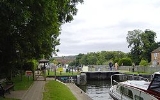
Temple Lock
Overview
Lock (water transport)
A lock is a device for raising and lowering boats between stretches of water of different levels on river and canal waterways. The distinguishing feature of a lock is a fixed chamber in which the water level can be varied; whereas in a caisson lock, a boat lift, or on a canal inclined plane, it is...
and weir
Weir
A weir is a small overflow dam used to alter the flow characteristics of a river or stream. In most cases weirs take the form of a barrier across the river that causes water to pool behind the structure , but allows water to flow over the top...
situated on the Buckinghamshire
Buckinghamshire
Buckinghamshire is a ceremonial and non-metropolitan home county in South East England. The county town is Aylesbury, the largest town in the ceremonial county is Milton Keynes and largest town in the non-metropolitan county is High Wycombe....
bank of the River Thames
River Thames
The River Thames flows through southern England. It is the longest river entirely in England and the second longest in the United Kingdom. While it is best known because its lower reaches flow through central London, the river flows alongside several other towns and cities, including Oxford,...
near Temple Mill Island
Temple Mill Island
Temple Mill Island is an island in the River Thames in England upstream of Marlow, and just downstream of Temple Lock. It is on the southern Berkshire bank close to Hurley....
opposite Temple Meadows and not far from Hurley, Berkshire
Hurley, Berkshire
Hurley is a village and civil parish in the English county of Berkshire.Hurley is famous for its proximity to the River Thames. It is also within easy reach of Henley-on-Thames, Oxford and London. The parish includes the villages and hamlets of Cockpole Green, Warren Row, Knowl Hill, Burchett's...
. It was first built by the Thames Navigation Commissioners in 1773.
The weir runs across from the lock to the Berkshire bank a short distance upstream of the lock.
There are references to a flash lock
Flash lock
Early locks were designed with a single gate, known as a flash lock or staunch lock. The earliest European references to what were clearly flash locks were in Roman times....
and winch in the 16th century. There was also a ferry at the lock.
The pound lock was built in 1773, the sixth downstream of the eight constructed after the passing of the 1770 navigation act.

